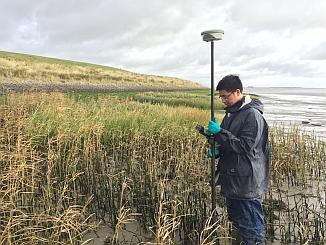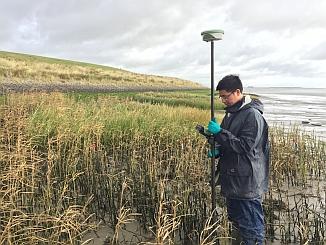
Credit: Photo NIOZ
Dikes could be lower if they are protected against the waves by grassy marshes. But the protective salt marsh grass is struggling to stay alive, and this is not only due to increasingly stronger waves in the face of climate change. Another serious threat to marshes is caused by ragworms: sophisticated gardeners were discovered to turn inedible, tough grass seeds into succulent, nutritious sprouts in their burrows. While the sprout-growing worms thrive on this superfood diet, their cultivation techniques prevent many seeds from growing into salt marsh vegetation, thus undermining the use of salt marshes for 'natural' coastal protection. This finding could help to outsmart the ragworms and make managing salt marshes more effective. Instead of planting seeds, successful restoration of marshes could be jump started by planting bigger plants,which are not eaten by the worms. Zhenchang Zhu, researcher at NIOZ (Royal Netherlands Institute for Sea Research) will defend his PhD thesis on these findings at Radboud University on Monday 20 March 2017.
Due to its strong wave reduction capacity, coastal vegetation is often proposed as a natural, 'building-with-nature' inhibitor of wave-energy, next to 'hard' coastal protection measures like dikes. However, coastal marshes have been degrading around the globe. Restoration efforts to increase the size of salt marshes often fail due to problems in seedling establishment of marsh plants in the harsh coastal environment. To succeed, a sufficient number of seeds need to be buried at just the right depth; too shallow means they will be washed away, too deep means the sprouting seeds will not reach the surface.
Climate change impacts
Whether the depth of seed burial is 'good' depends on wave conditions and the associated stability of the sediment. Zhenchang Zhu: "The regeneration from seeds, which is key to the establishment and lateral growth of coastal marshes, is likely to become more difficult in the future. Rising sea levels and increasing storminess may intensify wave forces on tidal flats. In the end, these climatological factors will make it harder for the seeds to persist in tidal flats, or even speed up the lateral retreat of the marsh edge. This decreases the long-term reliability of salt-marshes as a nature-based way of coastal flood protection".
Bio-threat
Ragworms (Hediste diversicolor) living in burrows in the sediment of tidal flats and saltmarshes are opportunistic feeders and were already known to eat practically anything, usually low-grade vegetable and animal waste material (detritus). But not grass seeds; although these are more nutritious, for ragworms the seeds are difficult to eat due to their large size and hard husk. To his surprise, Zhenchang Zhu and his team discovered that ragworms in fact have a sophisticated farming method to turn the hard seeds into juicy sprouts that are easy to digest: they bury the seeds in their burrows and leave them there to germinate before eating them. Zhenchang Zhu: "Until our discovery, this practice was only known from people. For centuries, bean sprouts and cress have been part of the diet of people in East Asia. Currently, the sprouted food is quite popular in the West as a 'superfood' because it contains high levels of proteins and vitamins. The seedlings of the cord grass can be regarded as superfood for the ragworms as well. In our laboratory study, worms that were fed on sprouts became 20% heavier than the worms that were fed on detritus."
###
Thesis: Zhenchang Zhu (2017). Seed fate in space and time. Implications for regeneration of coastal wetlands. PhD thesis, Radboud University Nijmegen: 141 pp. No ISBN: 978-94-6295-564-6.
Media Contact
Zhenchang Zhu
[email protected]
@NIOZnieuws
http://www.nioz.nl
############
Story Source: Materials provided by Scienmag





